厦门大学:《海洋环境化学》课程教学资源(PPT课件)Chap 01 Mechanisms and problems of marine pollution
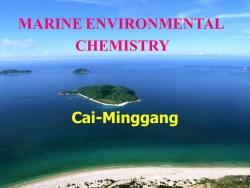
MARINE ENVIRONMENTAL CHEMISTRY Cai-Minggang
MARINE ENVIRONMENTAL CHEMISTRY Cai-Minggang
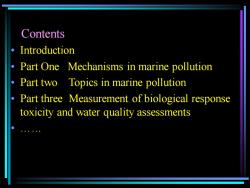
Contents • Introduction • Part One Mechanisms in marine pollution • Part two Topics in marine pollution • Part three Measurement of biological response toxicity and water quality assessments •
Contents • Introduction • Part One Mechanisms in marine pollution • Part two Topics in marine pollution • Part three Measurement of biological response toxicity and water quality assessments •
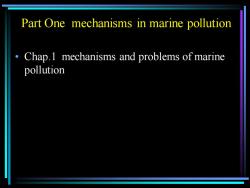
Part One mechanisms in marine pollution • Chap.1 mechanisms and problems of marine pollution
Part One mechanisms in marine pollution • Chap.1 mechanisms and problems of marine pollution
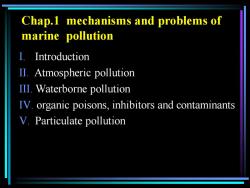
Chap.1 mechanisms and problems of marine pollution I. Introduction II. Atmospheric pollution III. Waterborne pollution IV. organic poisons, inhibitors and contaminants V. Particulate pollution
Chap.1 mechanisms and problems of marine pollution I. Introduction II. Atmospheric pollution III. Waterborne pollution IV. organic poisons, inhibitors and contaminants V. Particulate pollution

I. Introduction A. Mechanisms in pollution B. Geochemical mechanisms C. The orgin and development of the biosphere
I. Introduction A. Mechanisms in pollution B. Geochemical mechanisms C. The orgin and development of the biosphere
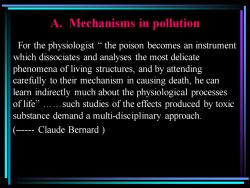
A. Mechanisms in pollution For the physiologist “ the poison becomes an instrument which dissociates and analyses the most delicate phenomena of living structures, and by attending carefully to their mechanism in causing death, he can learn indirectly much about the physiological processes of life” .such studies of the effects produced by toxic substance demand a multi-disciplinary approach. (- Claude Bernard )
A. Mechanisms in pollution For the physiologist “ the poison becomes an instrument which dissociates and analyses the most delicate phenomena of living structures, and by attending carefully to their mechanism in causing death, he can learn indirectly much about the physiological processes of life” .such studies of the effects produced by toxic substance demand a multi-disciplinary approach. (- Claude Bernard )
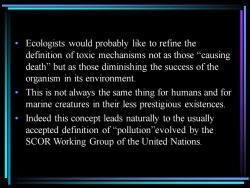
• Ecologists would probably like to refine the definition of toxic mechanisms not as those “causing death” but as those diminishing the success of the organism in its environment. • This is not always the same thing for humans and for marine creatures in their less prestigious existences. • Indeed this concept leads naturally to the usually accepted definition of “pollution”evolved by the SCOR Working Group of the United Nations
• Ecologists would probably like to refine the definition of toxic mechanisms not as those “causing death” but as those diminishing the success of the organism in its environment. • This is not always the same thing for humans and for marine creatures in their less prestigious existences. • Indeed this concept leads naturally to the usually accepted definition of “pollution”evolved by the SCOR Working Group of the United Nations
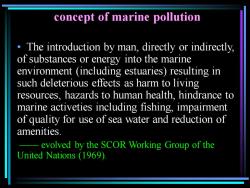
concept of marine pollution • The introduction by man, directly or indirectly, of substances or energy into the marine environment (including estuaries) resulting in such deleterious effects as harm to living resources, hazards to human health, hindrance to marine activeties including fishing, impairment of quality for use of sea water and reduction of amenities. —— evolved by the SCOR Working Group of the United Nations (1969)
concept of marine pollution • The introduction by man, directly or indirectly, of substances or energy into the marine environment (including estuaries) resulting in such deleterious effects as harm to living resources, hazards to human health, hindrance to marine activeties including fishing, impairment of quality for use of sea water and reduction of amenities. —— evolved by the SCOR Working Group of the United Nations (1969)
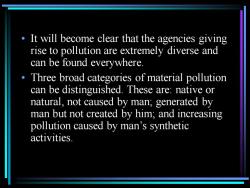
• It will become clear that the agencies giving rise to pollution are extremely diverse and can be found everywhere. • Three broad categories of material pollution can be distinguished. These are: native or natural, not caused by man; generated by man but not created by him; and increasing pollution caused by man’s synthetic activities
• It will become clear that the agencies giving rise to pollution are extremely diverse and can be found everywhere. • Three broad categories of material pollution can be distinguished. These are: native or natural, not caused by man; generated by man but not created by him; and increasing pollution caused by man’s synthetic activities
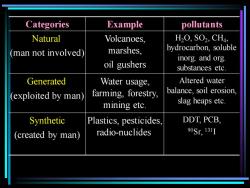
Categories Example pollutants Natural (man not involved) Volcanoes, marshes, oil gushers H2O, SO2 , CH4 , hydrocarbon, soluble inorg. and org. substances etc. Generated (exploited by man) Water usage, farming, forestry, mining etc. Altered water balance, soil erosion, slag heaps etc. Synthetic (created by man) Plastics, pesticides, radio-nuclides DDT, PCB, 90Sr, 131I
Categories Example pollutants Natural (man not involved) Volcanoes, marshes, oil gushers H2O, SO2 , CH4 , hydrocarbon, soluble inorg. and org. substances etc. Generated (exploited by man) Water usage, farming, forestry, mining etc. Altered water balance, soil erosion, slag heaps etc. Synthetic (created by man) Plastics, pesticides, radio-nuclides DDT, PCB, 90Sr, 131I
按次数下载不扣除下载券;
注册用户24小时内重复下载只扣除一次;
顺序:VIP每日次数-->可用次数-->下载券;
- 厦门大学:《海洋生态学》课程教学资源(PPT课件)第十三章 保护海洋生物多样性.ppt
- 厦门大学:《海洋生态学》课程教学资源(PPT课件)第十二章 海洋污染和赤潮现象.ppt
- 厦门大学:《海洋生态学》课程教学资源(PPT课件)第十一章 海洋渔业资源的科学管理.ppt
- 厦门大学:《海洋生态学》课程教学资源(PPT课件)第十章 海洋主要生态系统类型.ppt
- 厦门大学:《海洋生态学》课程教学资源(PPT课件)第九章 海洋生态系统的分解作用与生物地化循环.ppt
- 厦门大学:《海洋生态学》课程教学资源(PPT课件)第八章 海洋生态系统的能流及次级生产力.ppt
- 厦门大学:《海洋生态学》课程教学资源(PPT课件)第七章 海洋初级生产力.ppt
- 厦门大学:《海洋生态学》课程教学资源(PPT课件)第六章 生物群落的组成、结构和生态演替.ppt
- 厦门大学:《海洋生态学》课程教学资源(PPT课件)第五章 海洋生物群落中的种间关系.ppt
- 厦门大学:《海洋生态学》课程教学资源(PPT课件)第四章 生态系统中的生物种群.ppt
- 厦门大学:《海洋生态学》课程教学资源(PPT课件)第三章 海洋非生物生态因子及其生态作用.ppt
- 厦门大学:《海洋生态学》课程教学资源(PPT课件)第二章 海洋环境与海洋生物生态类群.ppt
- 厦门大学:《海洋生态学》课程教学资源(PPT课件)第一章 生态系统概述.ppt
- 厦门大学:《海洋生态学》课程教学资源(PPT课件)绪论(授课教师:黄凌风、郭丰).ppt
- 海南大学:《城市生态学》课程教学课件(PPT讲稿)第七章 城市景观生态.pptx
- 海南大学:《城市生态学》课程教学课件(PPT讲稿)第五章 城市环境.ppt
- 海南大学:《城市生态学》课程教学课件(PPT讲稿)第六章 城市灾害及其防治.ppt
- 海南大学:《城市生态学》课程教学课件(PPT讲稿)第八章 城市环境质量评价与可持续发展.ppt
- 海南大学:《城市生态学》课程教学课件(PPT讲稿)第九章 城市与社区的可持续发展.ppt
- 海南大学:《城市生态学》课程教学课件(PPT讲稿)第一章 绪论.ppt
- 厦门大学:《海洋环境化学》课程教学资源(PPT课件)Chap 11 Marine radioactive and thermal pollution.ppt
- 厦门大学:《海洋环境化学》课程教学资源(PPT课件)Chap 12 The protection of marine environment 海洋环境保护.ppt
- 厦门大学:《海洋环境化学》课程教学资源(PPT课件)Chap 02 Marine oxygen-demanded organic pollution.ppt
- 厦门大学:《海洋环境化学》课程教学资源(PPT课件)Chap 03 Marine eutrophication and Red tide(part 1).ppt
- 厦门大学:《海洋环境化学》课程教学资源(PPT课件)Chap 04 Marine eutrophication and Red tide(part 2).ppt
- 厦门大学:《海洋环境化学》课程教学资源(PPT课件)Chap 05 Marine eutrophication and Red tide(part 3).ppt
- 厦门大学:《海洋环境化学》课程教学资源(PPT课件)Chap 06 Marine eutrophication and Red tide(case study)大鹏湾环境与赤潮的研究.ppt
- 厦门大学:《海洋环境化学》课程教学资源(PPT课件)Chap 07 Oil pollution of the sea 海洋石油污染(part 1/2).ppt
- 厦门大学:《海洋环境化学》课程教学资源(PPT课件)Chap 08 Oil pollution of the sea 海洋石油污染(part 2/2).ppt
- 厦门大学:《海洋环境化学》课程教学资源(PPT课件)Chap 09 海洋合成有机化合物污染 Maine Persistent Organic Pollutants(POPs)pollution(part 1/2).ppt
- 厦门大学:《海洋环境化学》课程教学资源(PPT课件)Chap 09 海洋合成有机化合物污染 Maine Persistent Organic Pollutants(POPs)pollution(part 2/2).ppt
- 福州大学:《水污染控制工程》课程教学资源(PPT课件)第一章 污水水质与污水出路.ppt
- 福建船政交通职业学院:《环境监测》课程教学实验指导书(共十六个实验).doc
- 福建船政交通职业学院:《环境监测》课程电子教案(授课讲义,负责人:陈健).doc
- 福建船政交通职业学院:《环境监测》课程教学课件(PPT讲稿)第一章 绪论.ppt
- 福建船政交通职业学院:《环境监测》课程教学课件(PPT讲稿)第三章 大气和废气监测.ppt
- 福建船政交通职业学院:《环境监测》课程教学课件(PPT讲稿)第二章 水和废水监测.ppt
- 福建船政交通职业学院:《环境监测》课程教学课件(PPT讲稿)第七章 噪声污染监测.ppt
- 福建船政交通职业学院:《环境监测》课程教学课件(PPT讲稿)第九章 监测过程的质量保证.ppt
- 福建船政交通职业学院:《环境监测》课程教学课件(PPT讲稿)第五章 土壤污染监测.ppt
